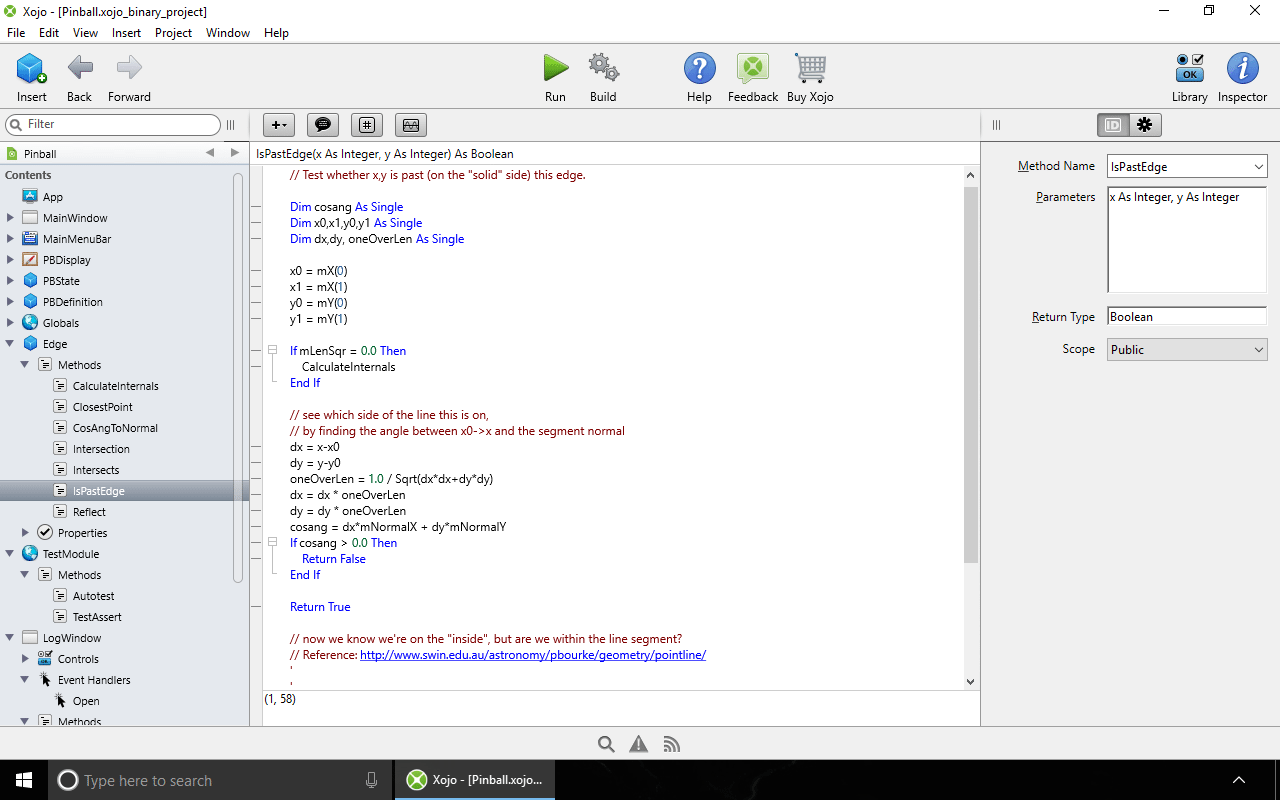- Xojo is a Developer Tools application like R for Windows, GdPicture.NET, and dotConnect from Xojo, Inc. It has a simple and basic user interface, and most importantly, it is free to download. Xojo is an efficient software that is recommended by many Windows PC users.
- Xojo free cracked allows entry to a whole suite of instruments for creating, working, debugging, and constructing purposes from inside the similar improvement atmosphere. An unconventional strategy that’s appropriate for many who must develop multi-platform apps. We may begin by saying a number of issues about Xojo.
- GrapeCity Developer Solutions product lines include Documents, document APIs for Excel and PDF; ComponentOne, a collection of.NET and Xamarin UI controls; ActiveReports, a complete.NET reporting solution; Spread, a collection of.NET and JavaScript spreadsheet solutions; and Wijmo, a complete library of JavaScript UI controls for Angular, AngularJS, React, and Vue.
- Xojo is a modern object oriented language and is quite powerful but it’s not a popular language. Many developers have never heard of Xojo. There is no standards committee that adds features to the language and the language itself is closed source.
The object-oriented Xojo programming language and cross-platform rapid application development tool let you develop native applications for macOS, Windows, Linux, the web, iOS and Raspberry Pi. User interfaces are quickly and intuitively made with drag and drop and the modern framework supports features like graphics, database servers.
From Xojo Documentation
- 1Desktop Fonts
A font defines how text is displayed on the screen. Typically a font has a family, such as 'Helvetica, Times, Courier, etc.' and a corresponding size that is usually measured in points.
For most of your apps you will want to use the system standard font size and point size so that things are as readable as possible and so that any changes the user makes to accessibility settings (to alter font readability) are properly used by your app.
Still, there may be cases when you need to choose a specific font for your text display. This topic describes how that works for desktop, web and iOS projects.
Desktop Fonts
You have the ability to set the font, font size, and font style of many of the objects and controls in your app. Text Areas support multiple fonts, styles, and sizes (collectively referred to as styled text) and List Boxes support multiple styles as well. Desktop controls that use a single font have a TextFont property that you can set by assigning it the name of the font you want used to display text for the control. Additionally, many controls also have checkboxes to specify if the font should be Bold, Italic or Underlined.
Text Areas have a TextFont property but they can also display multiple fonts and all kinds of formatted text. For information on this, refer to the UserGuide:Styled Text topic.
System and SmallSystem Fonts
The System font is the font used by the system software as its default font. It's the font used for the menus as well. This font varies by operating system and the user's preferences.
If you want text to be shown using the user’s System font, use the name 'System' as the font when you assign it. You can enter it as the TextFont property in the Inspector. If you also enter zero (0) as the font size, the font size that works best for the platform on which the app is running is used. Because of differences in screen resolutions, different font sizes are often required for each operating system platform. This feature enables you to use different font sizes on different platforms without having to create separate windows for each platform. Use the Inspector to set the font name to “System” and the font size to zero (0).
If the system software supports both a large and small System font, you can also specify the 'SmallSystem' font as the font name. This option selects the small system font on the user's computer, if there is one. If there is no small system font, the System font is used.
On Mac, both System font and the Small System font are supported.
Available Fonts
You may want to use fonts other than the System font. In this case you will need to determine if a particular font is installed on the user's computer. There are two global functions, FontCount and Font, that make determining available fonts easy.
The following function, when passed a font name, will return True or False to inform you if the font is installed:
Var i AsInteger
For i = 0To System.FontCount - 1
If System.FontAt(i) = FontName Then
ReturnTrue
End If
Next
ReturnFalse
End Function
Building a Font Menu Dynamically
Suppose you want to create a Fonts menu that will display all the fonts on the user's computer. You don’t know which fonts are installed in advance, you need to create the menu dynamically when the app starts.


To do so, you create a instance of the MenuItem class and instantiate it for each font. The Action event for the class instance handles the menu selection. The UserGuide:Desktop Menus topic shows you how to do this.
Mac Fonts

With Mac apps, not all fonts can appear as Bold, Italic or Underlined even if those properties are selected. Because of the way Mac draws fonts, Bold, Italic and Underline are only displayed for fonts that include it as part of the font definition. These settings cannot be applied to just any font as they can be on other platforms. Instead, on Mac Xojo has to look up the specific font to use based on what you set for font properties.
If you are not seeing the font setting you expect, be sure to verify that the font itself supports it, which you can do using TextEdit or the Font Book app.
On newer version of MacOS (starting with Sierra) your apps may perform slower if you are relying on Xojo to do font lookups. Here is an example of what happens behind the scenes.
Say you want 'Arial' in Bold to draw on a Graphics surface of a Canvas with code like this:
Xojo takes the font family name (Arial) and the fact that you enabled the Bold property and finds the correct font variant in the 'ArialMT' font, which is has this PostScript name: 'Arial-BoldMT'. It then uses that font to do the actual drawing. You can look up these names yourself using the Mac Font Book app.
If this causes performance issues in your app, you can avoid the lookup by directly specifying the PostScript font name (and not using the Bold or Italic properties). For example instead of the code above, you can do this:
Web Fonts
For web apps, you use the control's Style property to set the font or do it through the Inspector.
You can add any of Google's web fonts to your web app as well.
iOS Fonts
For iOS apps, you use the Font class to specify font settings for display. It has a constructor that takes a parameter for the font's postscript name and point size. For example, this code can set a button text to use Arial at 18 point:
Button1.CaptionFont = courier
To use the system font, you can use the shared methods like this:
You can also set fonts for the Text Field and Text Area controls using the advanced tab of the Inspector.
See Also
Font class; System.FontAt, System.FontCount methods; Changing the Appearance of Web Controls, UserGuide:Styled Text topics
I’ve been a member of the Xojo community for nearly twenty years. In that time I’ve seen a lot of people join the community, become fantastic contributors, and then suddenly leave the community. There are a lot of reasons developers would leave the community but I thought I’d capture some of them.
Xojo scratches an itch and if the developer no longer has the need to scratch that itch they use a tool that scratches their next itch. Xojo is great for cross-platform applications but certainly less so if you need only a Mac or only a Windows application. Xojo’s strength is cross-platform which means compromises in abilities and controls so I can understand people wanting a pure Windows or MacOS application. Apple and Microsoft have large developer communities that are attractive.
Xojo M1
The Rapid Release Program held much promise when it was introduced many years ago. Xojo went from two big monolithic releases a year to three, four or more releases per year. Sure, Xojo fixes a ton of stuff in each release but they also seem to break stuff in each release. I know we have a list of verboten releases for various platforms and it gives the impression of a perpetual beta status for Xojo. I have been a big fan of releases that are almost all bug fixes with no new features but those are pretty rare.
Xojo.com

Xojo is a modern object oriented language and is quite powerful but it’s not a popular language. Many developers have never heard of Xojo. There is no standards committee that adds features to the language and the language itself is closed source. If there was a standards committee I suspect there would be some serious language additions done sooner rather than later. It certainly would have given much more forethought into API 2.0 and how it would affect the existing user base and the documentation done long before any coding started.
Xojo isn’t like any other development tool I’ve ever used. It’s great that it doesn’t allow a developer to make a stupid mistake when declaring a method. It forces you to use the Xojo IDE user interface to do everything from creating methods, declaring properties, constants, enums, etc. I’ve never used another developer tool that does this. Xojo pretty much forces you to use it the way they want you to rather than what most other languages do with a text editor. This makes it easier for beginners but if I’m being honest it’s a drag for someone like me that (usually) knows what they are doing. Forcing developers into the Xojo-way of doing things makes the IDE seem like a toy at times. It’s certainly slower.
Change does not happen quickly with Xojo. It has a small development staff and I’m always amazed at how much they get done. But it means that it can take an incredibly long time for things to change and become stable. The transition to 64-bit was a huge multi-year project. iOS was a huge multi-year project. Web 2.0 and Android have become huge multi-year projects (with still no idea on when we’ll see them). The new targets might be good eventually but history shows it will take a few releases before they’re really stable. Meanwhile older targets seem to get significantly less attention.
Xojo isn’t really a business development tool. When I say business I mean databases and reports because that’s practically every application we’ve done for the past twenty years. Doing database development in Xojo is NOT Rapid Application Development (RAD) because you have to deal with everything database related yourself and the IDE and compiler give you zero help. Reports are simplistic and aren’t exceptionally powerful and there’s no way for an end user to create or edit reports. There’s a reason why BKeeney Software has its own database Object Relation Model (ORM) classes and reporting tools and classes because we have to use them in nearly every project we do for clients.

In addition to all that it’s really missing some things that business users need. The TextArea control has pitiful RTF support, there is no built-in calendar, date, or time controls. The built-in grid (Listbox) is more powerful than many people give it credit for but cannot hold native controls and can be very slow with large data sets. There is no PDF read or write support either. There are 3rd party options for all of these things but something lightweight would go a long way to supporting new business users.
These are a few of my thoughts. What am I missing about developers that leave Xojo? And is there a way to stop them from moving away from Xojo? What are they doing to?

Comments are closed.